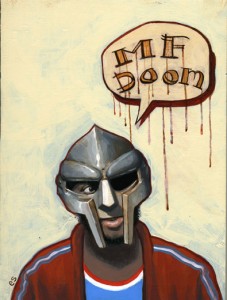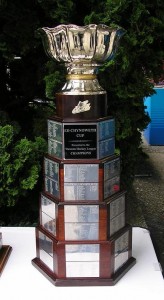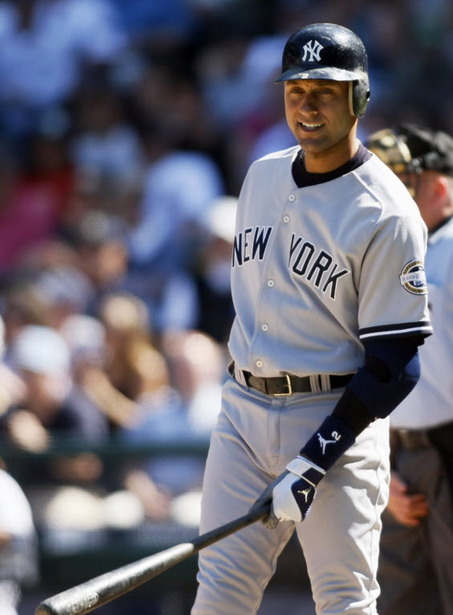Let’s try a little positivity…
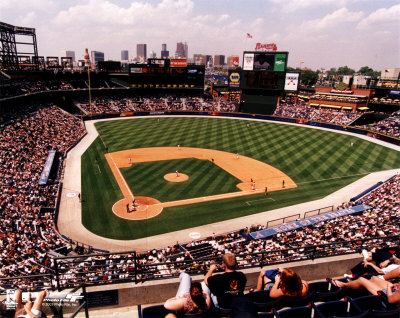
One of the things I love about baseball is the relaxing atmosphere of afternoon games, particularly when broadcast from Turner Field on Peachtree TV.
I’m reading Sports Illustrated’s Great Baseball Writing and I’ve learned something from the various essays and articles in the volume – the great American pastime is always in a state of hand-wringing about the State of the Game.
Think about it. At the turn of the 20th century there was great concern over the hoodlums who played the game. The 20s were marred by gambling scandals, primarily the one revolving around the Chicago White Sox and the 1919 World Series. After that was World War II, segregation, integration, labour strife and, most recently, steroids.
There’s always a new problem plaguing the sport.
In all that doom and gloom there isn’t enough talk about what makes baseball great. I’m as guilty of this pessimism as the next person. This season alone I’ve taken shots at my hometown Toronto Blue Jays, complained about lengthy games and weighed-in on Joe Cowley and talk of moving the Jays.
So let’s get positive. Let’s talk about three things that I love about baseball.
1) Afternoon Games
Nobody likes to work during the summer. It’s a drag. Everyone would much rather be outside, enjoying the sun. Unfortunately, employment is a necessary element of being a part of today’s society.
However, baseball matinees can provide some respite from the drudgery of work. Following the game on the radio, on TV or on the Internet is always a pleasant distraction from a job.
A particular favourite of mine is to follow the Atlanta Braves on Peachtree. Their announcers are laid back and the fans at Turner Field are great. It’s always relaxing and fun to watch.
2) Tradition
I really enjoy the little social behaviours that surround baseball games. Waiting for the half inning to return to your seat after a trip to the concession stand. Judging a person’s character based on whether or not they use the real pitcher’s rubber during the opening pitch. Singing, stretching and dancing during the seventh inning stretch. They’re all good.
A particular favourite is the habit of Torontonians to boo any opposing team that dares to have a mound meeting or try to pick-off a runner. No matter what the situation, Jays fans go nuts at the very thought of another team trying to invoke strategy.
3) The Fans
Baseball fans can’t compete with other sports’ supporters in terms of passion or intensity, but they are definitely smarter. Hockey fans, as much as I love ‘em, are basically only capable of three sounds – boo, cheer and Go <team name> Go! The rest of the game is spent in a fixed state of concentration. Football and basketball fans are much the same.
However, baseball fans sing songs together, come up with chants, and best of all heckle. No matter where they’re sitting in a stadium they will yell at the top of their lungs lengthy diatribes on their target’s short-comings as a player.
Their knowledge of bench players and opposing teams runs deep too, with many fans citing the personal lives of the athlete. Remember when it was rumoured that Alex Rodrgiuez was stepping out on his wife with Madonna? Good times. Truly, a golden age of heckling.
Tempest in a tea pot: thoughts on the Joe Cowley controversy
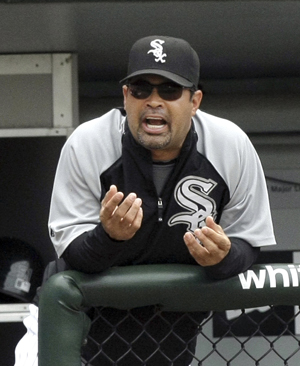
Chicago White Sox manager Ozzie Guillen was the voice of reason in the Joe Cowley controversy? Weird.
Last Thursday the Toronto sports blogosphere was aflame with controversy over a web article written by Chicaco Sun-Times beat reporter Joe Cowley titled “No, Canada, for MLB”. In short, it was about how the Blue Jays are a moribund franchise that should be moved.
As a Torontonian - born and bred -I had a very strong, knee-jerk reaction to reading this. After all, who is this guy? I don’t know him from Adam. Doesn’t he know that we’re the centre of the universe?
Reading Cowley’s Wikipedia profile did little to mitigate my rage. I mean, who wouldn’t be inflamed when he “protests” Canada by refusing to stand during the national anthem? The two incidents make him appear ignorant and ethno-centric.
However, after a day or two of reflection I calmed down. After all, Cowley clearly didn’t know what he was talking about. He was probably just trying to get a reaction from loyal Blue Jays fans.
This morning, Cowley appeared on the Fan 590’s Big Early with Don Landry and Gord Stelleck where he defended himself admirably, pointing out that his infamous remark that Toronto was “nothing but a city in a third-world country” was taken out of context.
However, Cowley stuck to his guns and reiterated his belief that the Blue Jays should be moved. He re-stated his beliefs that Venezuela deserves a team and that, aside from political reasons, it would work in Caracas, the capital of the country.
Cowley had addressed this idea in his article, with supporting quotes from White Sox manager Ozzie Guillen and pitcher Freddy Garcia. Both Venezuelans spoke about how popular a team would be in Caracas.
That’s entirely fair comment. It would be popular. Economically viable? No. Politically possible? No. Safe? Not even a little. But boy, there would be crowds.
Ask any Winnipeg Jets supporter – drawing a crowd isn’t enough. You need the backing of a strong business community. Caracas lacks that kind of legitimate financial support.
Also, let’s consider who he asked – two proud nationalists who, as fans, would undoubtedly love to see a major league team in their country. I can entirely sympathize. As a Canadian I love having a Major League Baseball franchise in my country, and am sorry that Montreal lost the Expos.
Hell, if my heart had its way every major Canadian city would be represented in the National Hockey League and MLB. It just isn’t a realistic desire.
It’s worth noting that neither Guillen or Garcia said that the Jays should be moved there or that the Toronto franchise should be moved at all. They just said that they’d like a team in Venezuela.
Guillen did speak about how the dwindling fan support, compared to the Jays dynasty of the early 1990s, is a sad state of affairs. Again, I agree. It is sad. But the White Sox manager never explicitly said that the team should be folded or relocated. He was just commenting on the rather pathetic attendance figures.
As for Rios’ and his claim that “There's that small group of diehards, but it’s hockey, hockey, hockey. It’s gotten sad here. They just don’t really care.” It’s hard to believe that he doesn’t have some resentment toward Toronto after he was put on waivers by the Blue Jays last season.
Jays fans certainly don’t like him: he had been booed during each of his at-bats over the course of the four-game series.
At the end of the day, I think Cowley’s article reads like a combination of someone with an agenda to push and someone looking for some cheap heat, trying to get a rise out of a beleaguered fan base to generate some hits for his web presence.
In all honesty, I’m sorry to have wasted 639 words on this “news”. Cowley’s already gotten enough attention for his ill-considered article.
Busy week ahead…
This is going to be a crazy week here at JCH.com headquarters. In addition to my usual self-imposed blogging duties I’m working on an exciting freelance project for the Canadian Sports Hall of Fame.
Specifically, I’m doing brief profiles of honoured members Lionel Conacher, Angela James and Jacques Plante. My writing will be part of the displays at the new Hall of Fame that’s being built in Calgary’s Olympic Park.
In any event, I’ll try to keep the content coming in this space, but there is a good chance that I’ll miss a day or two this week.
Follow Friday – Blog Roll

Unfortunately, I could not find an image that combined books and mixed martial arts. You really don't want to Google Image search that either.
In the grand spirit of Twitter’s Follow Friday I figured I’d shed some light on three blogs maintained by close friends.
The Can-Lit Project
Written by my girlfriend Katy and her sister Tory, the Can-Lit project is a series of book reviews and essays about Canadian literature.
It all began when Katy decided that she wasn’t familiar with the Canadian canon, so she and her sister dedicated themselves to reading as many books from this great country of ours as is possible. The result has been intriguing, with both of them exploring classics of the genre as well as some titles that are less popular.
In their eight months of blogging they've put up 43 reviews of Canadian books. Most are fiction, but some are non-fiction.
This may be the Canadian studies graduate in me, but I think this is a very worthy pursuit. In particular, I’ve enjoyed the debates over titles like Life of Pi by Yann Martel. I’ve never read the novel myself, but I miss this kind of heated discussion from undergrad and it makes me want to read the book so I can weigh in as well.
If anything, this blog shames me into being better read and also reading more high quality books. One of my favourite blogs to read and not just for obvious personal reasons.
The Writer’s Pet
Speaking of debates from undergrad, my friend Lija also maintains a literary blog called the Writer’s Pet. Although we used to talk about CanLit in our glory days at the University of Toronto, she’s now moved on to sunny London, England where she continues to toil in the writing game.
Her blog and Twitter feed revolve around literary news and reviews and she occasionally posts interviews with authors like Gavin James Bower, Anna Lawrence Pietroni or Marina Endicott.
It’s a great website to check in on regularly since Lija always has something interesting going on, whether it be a new review or a discussion on unorthodox bookmarks.
Victor Bachmann
My girlfriend’s brother-in-law (the husband of Tory, co-writer of the Can-Lit Project), is a professional mixed martial artist who fights out of Edmonton. He recently started a blog to record his planning and training for a tournament at the end of April that will feature fighters from across Canada in an elimination tournament, much like the original Ultimate Fighting Championship.
There’s only a few posts so far, but that handful has been enlightening. Victor’s talked about his entrance into the sport, his experience fighting at The Fight Club 10: High Octane and coming up with a strategy for his next bout.
It’s a good read for anyone interested in seeing what it takes to be a high-calibre professional athlete or for any fans of MMA.
Why I love rap music
I’m not a particularly musical person – I was kicked out of the school band in grade 7 because I was so inept at playing the trumpet – but I love listening to music.
In fact, whenever I write I have my iTunes running on random shuffle. Although I’ve got an eclectic collection of songs, the vast majority of it is hip-hop.
The reason is simple - even though I’m a middle class white guy, rap music speaks to me more than any other genre. Sure, I like rock, country or even some classical music but for me, nothing compares to urban music.
I’ll be the first to admit I come from a very different world than most rappers. Aside from Drake – who grew up around the corner from my apartment – I can’t honestly say that I identify with the hard, impoverished world of many rappers. The violent and often criminal reality of a rapper like Snoop Dogg or Dr. Dre is something I’ve never experienced and hope I’ll never have to.
However, I can identify with Dr. Dre’s concerns about aging and re-establishing his personal identity as he does in the classic album Chronic: 2001. I can also empathize with Jay-Z on his track Young Forever from the Blueprint III. The subject matter may be foreign, but the themes are universal.
Unlike a lot of media, rap often conveys narratives with humour and playfulness that belies the seriousness of the content. As the Atlantic’s Ta-Nehisi Coates recently pointed out, a talented MC like Ghostface Killah can make you laugh while describing selling drugs in a school zone.
I think a fair comparison would be enjoying classic literature. I will never be in the dense colonial jungles like Kurtz in Heart of Darkness and I will never be a drug dealer like the Notorious B.I.G. in “Juicy”, but I can be moved by both.
However, hip-hop makes itself more accessible then a lot of other media by being the most culturally aware of all musical genres.
Lyrics refer to historical events, other musicians, television, comic books or movies. You just can’t find a line like Everlast’s “Because I can feel it in the air tonight/but yo I’m not Phil Collins/I’m more like Henry Rollins” in other kinds of media. At least, not often.
Whether it’s the Beastie Boys name-checking Star Trek, the various members of the Wu Tang Clan creating “secret identities” based off of super-heroes from Marvel Comics or MF Doom basing his entire persona of the villain of the same name, rappers locate themselves in a cultural context that any listener can easily identify.
It goes well beyond lyrical styling - the beat itself is often a sample from another song or a television show. Busta Rhymes using the theme from Knight Rider or DMX and Onyx using the intro to Welcome Back Kotter for “Slam Harder”.
The music itself is a clever nod to the urban environment that it’s created in.
Floating snippets of familiar hooks and beats and sampled choruses are reminiscent of music floating out of neighbourhood windows as you walk down the street. Thumping bass simulates the clacking of subway cars riding on aging tracks. Changing lyrical flow or rotating MCs is a lot like catching parts of a conversations as you pass people on the sidewalk.
It’s impossible to listen to Grand Master Flash and the Furious Five’s “the Message” and not recognize the frustrations of living in a city. The same can be said of Kurtis Blow and Run DMC’s collaboration for “8 Million Stories”.
This culturally-awareness is the great strength of rap. It makes it more relatable and current. These references helps hip-hop bridge significant divides like politics, gender, religion and, of course, race. Hip-hop inspires and entertains me like no other kind of music.
The World Cup should be watched with a grain of salt
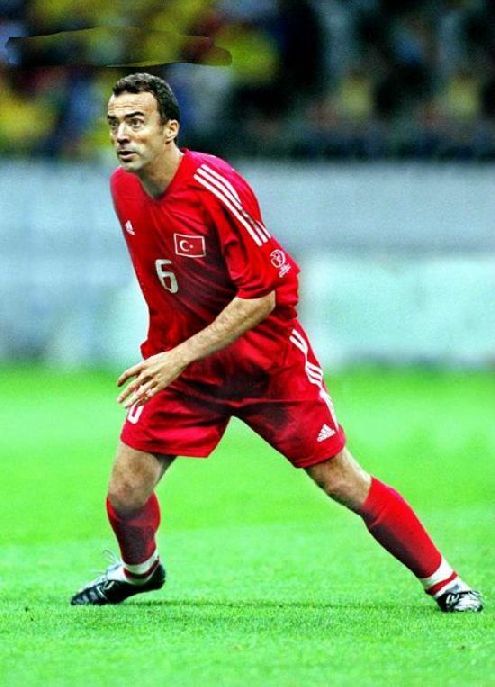
Turkey's Arif Erdem, shown here during his playing days for the national team, was arrested two weeks ago for his alleged involvement in match-fixing.
Although the playoffs (hockey and/or basketball, take your pick) still sit between us and the summer, the Canadian Broadcasting Corporation has already begun to promote their coverage of this year’s World Cup of Soccer in South Africa.
There’s a growing an air of excitement surrounding the tournament. After all, it’s the biggest sporting event in the world, even more popular than the Olympics.
Unfortunately, this time around I’m going to be watching the World Cup with a pretty sceptical eye.
My disillusionment began in Dec. 2008 as I read Declan Hill’s The Fix, an investigation into the world of sports fixing by a journalist who used to work with the CBC and the British Broadcasting Corporation.
I reviewed the book on my now defunct blog, but in short: Hill uncovered a far-reaching criminal underworld that exerts its influence over many sporting events. Hill chose to focus his investigation on soccer matches and his findings were startling.
According to him, there are two kinds of match-fixing scenarios.
1) Internal – When a member of a team gives incentives to officials or the players on opposing clubs to give his team an advantage.
Author Joe McGinniss details this kind of fix in The Miracle of Castel Di Sangro when he overhears several players discussing throwing their final game of the season against Bari. They had been asked to do this “favour” to insure that Bari would be promoted to Serie A.
2) External – When an outsider influences the outcome of a match for personal gain.
Obviously, this is the more typical kind of sporting corruption, with the Black Sox scandal, when the Chicago White Sox threw the 1919 World Series at the behest of Arnold Rothstein, serving as a sterling example.
In The Fix, Hill uncovers evidence of many professional matches being thrown world-wide. The climax of the book is when a mobster assures him that the World Cup itself is fixed. The gangster predicts the results of a handful of matches, down to when the goals are scored.
Hill watches with growing horror as each one of the games ends just as described.
Why is this pertinent now? Because last November German police arrested 15 people for fixing more than 200 games. Two weeks ago, Turkish police detained 40 people, including former international Arif Erdem, for their involvement in thrown matches.
Germany’s Bundesliga and Turkey’s Süper Lig are not the best professional soccer league’s in the world, but they are hardly fly-by-night organizations. In fact, the German national team is one of the best sides in the world and a contender for the 2010 World Cup.
With all this in mind, it will be hard to not be cynical when one of the favourites struggles against an opponent this summer. I simply can’t help but be a little jaded after reading The Fix and hearing about recent events in European soccer.
Major League Baseball needs to adjust its clocks
Although I’m just 26-years-old there are times when I feel old and curmudgeonly. Recently, my complaints have been directed at Major League Baseball’s handling of “event” games, whether they are the World Series, the World Baseball Classic, the All-Star Game or Opening Day.
All of these rather significant baseball games start way too late, they’re filled with time-consuming theatrics and the play itself seems to move at an incredibly slow pace. It makes me feel like an old crank shaking his walking cane at those damn kids who won’t get off my lawn.
However, NorthJersey.com reported Thursday morning that at least two MLB umpires - Joe West and Angel Hernandez – agree with me.
The two officials are members of the crew that have been calling the opening series between the Boston Red Sox and New York Yankees.
“They’re the two clubs that don't try to pick up the pace,” said West in the article. He is the chief of the umpiring crew and was behind home plate on Sunday. “They’re two of the best teams in baseball. Why are they playing the slowest?”
“It’s pathetic and embarrassing. They take too long to play.”
Amen, Joe West. Amen.
Hernandez refused three requests for timeouts during Tuesday night’s game. New York’s Derek Jeter, Marcus Thames and Boston's David Ortiz were all denied a pause from the ‘action’.
Despite West and Hernandez’s efforts to quicken their glacial pace, the Yankees and Red Sox first two games clocked in at 3 hours and 46 minutes and 3 hours and 48 minutes.
Maybe baseball players don’t have to work the next morning, but most people do. How is baseball supposed to cultivate a new audience of young fans when any responsible parent would be sending their kids to bed hours before these games lumber to an end? How are the paying customers expected to sit through nearly four hours of slow play?
Commissioner Bud Selig must find a way to curb these seemingly interminable games. Broadcasters must be haemorrhaging viewers with these lengthy match-ups and in the long run it’s going to shrink baseball’s market share.
Selig should move the time of the game up. Both games in the New York-Boston series were slated to start at 8 p.m. Eastern Daylight Time. How about moving the opening pitch up to 7 p.m.? At least that way the game will end on the same day, barring extra innings.
That’s another thing – when I say “opening pitch”, I do mean the first throw of the game. Not a fly over by the Air Force, the unfurling of a gigantic flag in the outfield or a performance by Jay-Z and Alicia Keys. If you must have all that pageantry, start it at 6 p.m. with the game itself beginning an hour later.
I know that this would effectively cut the West Coast off, but does Selig really want to be developing Yankee and Red Sox fans in California? Shouldn’t they be cheering for the five teams they already have?
Also, the most important part of any sporting event is the final result, and the Pacific Time Zone won’t be robbed of that. A Californian baseball fan who gets off work at 5 p.m. would only be missing the first half of the game.
Major League Baseball is famous for being slow to adapt to change, but enforcing a more reasonable time frame for their games is a pressing concern that Bud Selig should address sooner rather than later. After all, the clock is ticking.
The Case for Pat Burns’ early induction into the Hall of Fame
 A week ago I tweeted about the movement to have Pat Burns inducted into the Hockey Hall of Fame. I had wanted to expand on that 140-character missive, but the Easter holidays got in the way. However, now I’ve got the chance.
A week ago I tweeted about the movement to have Pat Burns inducted into the Hockey Hall of Fame. I had wanted to expand on that 140-character missive, but the Easter holidays got in the way. However, now I’ve got the chance.
As TSN later reported, the Facebook group Let's Get Pat Burns into the Hockey Hall of Fame - NOW! has the support of tens of thousands of hockey fans - over 49,000 as I write this – to put the former National Hockey League coach into the Hall of Fame before he succumbs to terminal cancer.
Other media outlets have picked up on the page, including Hockey Night in Canada, Coast to Coast with Don Cherry, the Montreal Gazette, the Toronto Sun, the Toronto Star and several radio stations.
Burns has a wealth of accomplishments that should earn him a spot in the Hall of Fame.
In his 14 straight seasons as a head coach he won 501 games with four teams, making it to the playoffs 11 times, the final twice and winning the Stanley Cup once.
To put that in a historical perspective, Burns is 11th in NHL history for number of games coached, nine behind Brian Sutter.
Burns is also 11th on the list for coaching wins, just one behind Hall of Fame member Glen Sather.
Even his losses stack up well, with Burns dropping 353 decisions in regulation and 14 in overtime (OTL was only counted in his last four seasons). That’s significantly less than Jacques Demers (468) and Brian Sutter (437), both of whom also coached for 14 years.
Granted, Burns doesn’t come anywhere close to the top 10 in terms of Stanley Cup wins, but he does at least have that one Stanley Cup ring from the 2002-03 New Jersey Devil’s championship, which is better than many other members of the Hall of Fame.
One could speculate that had it not been for Burns’ premature retirement, he’d have moved even further up these lists. Certainly, he could have moved up on the lists for games coached, and presumably climbed further up in terms of wins.
However, the Hall of Fame shouldn’t rely upon conjecture or presumptions. The man’s record speaks for itself. Even within the constraints of his shortened career he put together an exceptional coaching record.
The only question is whether or not Burns will be alive by the time he is inducted into the Hall of Fame.
Burns was present at the groundbreaking ceremony of a hockey arena that will be named in his honour two weeks ago. During the press conference, Burns was not optimistic about his chances of seeing the rink completed.
"I probably won't see the project to the end," said Burns. "But let's hope I'm looking down on it and see a young Wayne Gretzky or Mario Lemieux."
Normally, there is a three-year waiting period after retirement to gain admission to the Hockey Hall of Fame.
However, there is precedent for the Hockey Hall of Fame speeding the process up: Roger Neilson was fast-tracked as he was terminally ill, as was Mario Lemieux, whose Hodgkin's lymphoma appeared to be fatal.
Burns has everything going for him. He has a high-calibre resume, the support of many hockey insiders and the Hall of Fame has done this kind of promotion before.
All that’s left is for the selection committee to take note of his accomplishments and the groundswell of support for his induction. It would be a fitting cap to a stellar career and an inspiring life.
If you’d like to throw your support behind the Let's Get Pat Burns into the Hockey Hall of Fame - NOW! Facebook group, you can join by clicking on this link.

